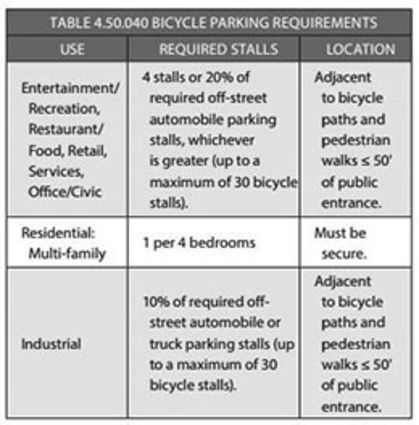City approves zoning overhaul
Shedding light on local issues.

Chapter 4.50 – Parking Standards 4.50.040 Bicycle Parking [new] For each 10 bicycle parking stalls provided, there shall be permitted a reduction of one required automobile parking stall to a maximum for 15 percent of the required automobile parking stalls, at the discretion of the Director or Commission. Bicycle stalls shall be improved in accordance with the following requirements: Provided with a device to be approved by the City and capable of supporting a bicycle in an upright or hanging position and having a means that will enable a user to lock his bicycle to such a device. Areas containing stalls shall be surfaced with hardscape or paving. When located within a parking area, spaces shall be protected by curbs, fences, planter areas, bumpers or similar barriers for the mutual protection of bikes, automobiles and pedestrians, unless deemed by the City to be unnecessary.
The Tehachapi City Council formally adopted a major update of the municipal zoning code in a 416-page document that incorporates a hybrid of conventional and form-based elements.
The document "is a reflection of us," City Manager Greg Garrett told the Council Oct. 20 at its regular meeting at the Wells Education Center.
"We are proud of this document," Garrett said. "It tells the story of what we do and how we do it, all the things we pride ourselves in. It tells a really good story."
Council member Kim Nixon, a former member of the Tehachapi Planning Commission who sits on the Local Agency Formation Commission (LAFCO), echoed the sentiment.
"This document was so exciting to read through, to understand what the city is doing," Nixon said.
Nixon said that such a document helps LAFCO do its work.
Tehachapi Planning and Community Development Director David James said the document, prepared by consultant Lisa Wise, is organized to be more user-friendly.
James said the city has tiered off the city's General Plan as the basis for compliance with the California Environmental Quality Act.
Tehachapi is ahead of all other cities in Kern County in its zoning update, Garrett said. The timeliness in preparing the document is linked to the completion and adoption of the General Plan on April 16, 2012, he said.
The process of bringing a zoning code into compliance with a General Plan is often referred to as a "Consistency Zoning" effort, James said in the staff report.
The city Planning and Community Development Department introduced the document on Oct. 6. The Tehachapi Planning Commission had approved the document on Sept. 8 following a workshop on Aug. 11.
Conventional zoning utilizes the familiar coding such as R-1 (single family residential).
Form-based zoning focuses on appearance and character of all the various elements, including facades, height, fences, parking, landscaping, pedestrian and other transportation corridors and a general "quality of life" atmosphere.
The document utilizes the concept of "Transect Zones," which identifies a gradient of zones from the denser downtown core to less dense to developed housing areas to – at the outer zone – sparsely inhabited rural areas. It is an ecological concept that abandons the entrenched system of lumping industrial, housing and commercial separately. Transect Zones allow for a blending between zones and include a more European village type vision, where a small convenience store may be permitted in a housing area. The document allows mixed-use construction that places living quarters atop commercial establishments in the core area.
"The form-based approach provides the city and development community more latitude and options," the staff report said. "Given that the document emphasizes design, in fill [building or upgrading property that is already built on, as with the Tehachapi Police Department building that was a former garment factory], and mixed use over function. In more conventional General Plan documents land uses are segregated and as such lack the nimbleness the new form based document affords. The nimbleness the form based approach affords the city not only enhances the city's land use potential, it has important economic development implications as well."
Form-based code will not be applied to the entire city.
"As a point of clarification," the staff report said, "it should be noted that the individual articles and chapters of the zoning code will not have both conventional and form-based elements. It is in this context that the zoning code can be characterized as a hybrid code. Early on in the zoning code update process, it was staff's intention to apply a form-based code city wide. However, after thoughtful consideration it was concluded that the existing neighborhoods located out of the downtown area should remain in place or retain the status quo. This decision was made so as not to get these neighborhoods unnecessarily concerned over the prospect of someone converting their single family residence into a beauty shop or local convenience store, for example. At some point in time these neighborhoods may be in a position or better suited to accommodate more of a mixed use concept, which can be accomplished using the form-based approach."
Staff decided that it would be premature to apply form-based codes on existing neighborhoods out of downtown, leaving them essentially unchanged from a a zoning perspective.
See the document online at http://www.tehachapicityhall.com, go to "City Clerk" on the drop-down menu under "Government" on the top bar of the home page; click on "Agendas;" click on "2014;" click on "10/20/2014 Attachment – Zoning Code Update."




